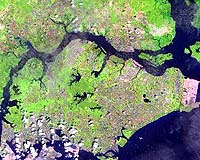 |
Washington DC (SPX) Jun 08, 2009 Elements of the soy industry have agreed to take a milestone step toward improving their production practices, which have led to widespread deforestation, displacement of small-farmers and indigenous peoples, and loss of natural habitats. On Thursday, participants in the Round Table on Responsible Soy (RTRS) unanimously agreed to implement a pilot program of voluntary production standards aimed at reducing the negative impacts of soy production on the environment and people, particularly in South America. Most importantly, the interim standards require producers to take certain measures to protect the environment. Those include prohibitions on the conversion of areas with high conservation value - such as forests and savannahs - reducing greenhouse gas emissions, and eliminating the most hazardous pesticides in soy farming. "The challenge now is to find mechanisms to reward producers who protect forests and soil by allowing them to sell carbon along with their soy," says Dr. Jason Clay, an expert on soy agriculture who leads World Wildlife Fund's (WWF's) work with international markets. "This is a win-win-win situation. Forests and soil are protected, producers have an additional source of income and retailers and brands can now buy responsible soy as a way to reduce their carbon footprint. Preliminary calculations suggest that producers in forest areas can net more income selling carbon than soy. This fundamentally changes soy and makes it a new kind of commodity." "We welcome this decision by RTRS members, but now the hard work begins to test and improve these standards over the next 12 months," says Cassio Moreira, Coordinator of WWF Brazil's Agriculture and Environment Program, who also serves on the RTRS board. "Everybody in the soy supply chain needs to jump into this process and make it work, especially the buyers who must show their commitment to support the implementation of these standards." The agreement is the result of years of dialogue between WWF, other NGOs, farmers, and the soy industry and was finalized at the group's fourth annual meeting this week in Campinas, Brazil. The RTRS currently counts more than 100 members, including major private interests in the soy industry, smallholder farmers, feed mill operators, traders, retailers, financial institutions, and social and environmental organizations. The program is based on a set of standards - known as Principals and Criteria- to improve soy production. They will be tested among several growers and then revised before the next RTRS meeting in 2010. Members will then take a final vote on long-term standards. The Principles and Criteria also require producers to: + Comply with the law and adopt good business practices. + Maintain good working conditions, such as paying workers the prevailing wage. + Dialogue with surrounding communities, such as equitably resolving land disputes. + Engage in good agricultural practices, such as reducing soil erosion, water use and pollution, and the safe handling and minimizing the use of agrochemicals. The RTRS now needs to maintain momentum by developing a certification system to verify compliance with the standards and establish methods to trace the soy. Expanding soy production has been linked to the dramatic loss of natural habitats, especially forests and savannahs, in South America. Soy fields have already replaced much of Brazil's savannahs - the Cerrado - and are threatening the Amazon by pushing cattle ranching into that area. The expansion of soy production also threatens the livelihoods of local communities. Agriculture contributed to the disappearance of most of the Atlantic Forest in southern Brazil and eastern Paraguay in the 1970s and 1980s - a scenario that could be repeated in other regions as the global demand for soy is expected to double by 2050. Soybeans are used in the production of edible oil, cosmetics, foods, and feed for cattle, pigs, poultry and fish. More recently, soy has been used in the production of biofuels to meet increasing energy needs. Share This Article With Planet Earth
Related Links WWF Farming Today - Suppliers and Technology
 Sky's the limit for Singapore gardens
Sky's the limit for Singapore gardensSingapore (AFP) June 5, 2009 When Albert Quek first moved into his home on the top floor of an eight-storey apartment block, he agonised about the limited space he had to pursue his passion for gardening. All he had was a one-square-metre (10.8-square-foot) balcony, barely large enough for his wife to sun the laundry, let alone for him to nurture a garden. Then he had a brainwave. "Why don't I do something verti ... read more |
|
| The content herein, unless otherwise known to be public domain, are Copyright 1995-2009 - SpaceDaily. AFP and UPI Wire Stories are copyright Agence France-Presse and United Press International. ESA Portal Reports are copyright European Space Agency. All NASA sourced material is public domain. Additional copyrights may apply in whole or part to other bona fide parties. Advertising does not imply endorsement,agreement or approval of any opinions, statements or information provided by SpaceDaily on any Web page published or hosted by SpaceDaily. Privacy Statement |